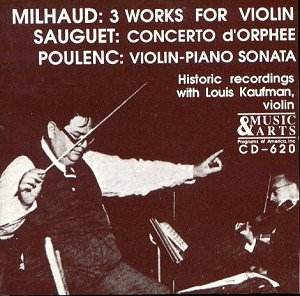My last
review of Louis Kaufman’s bewitching violin playing was of
a late recording of Telemann and Spohr, collated by Music and
Arts. This one concentrates on apt and congenial repertoire, not
least because of his friendships with at least two of the three
composers. His association with Milhaud began at Mills College
in 1938 and his propagandist work consisted of a number of American
première performances as well as a Parisian debut with
the Second Violin Concerto in an all-Milhaud concert conducted
by the composer. Similarly his friendship with Poulenc led to
Kaufman’s championing of the Violin Sonata in America; together
composer and violinist performed the revised version of the sonata
in Paris, a performance dedicated to the memory of Ginette Neveu,
for whom the work had been written. Kaufman doubtless knew Sauguet
as well and his buoyant playing in the Concerto d’Orphée
clearly demonstrates his affinity.
His legendarily intense vibrato and voluptuous
tone might not be thought necessarily fruitful adjuncts for this
repertoire but Kaufman shows that coiled expressivity has its
place in these works. Neveu’s intensity, after all, was equally
powerful, though the way in which she deployed it differed more
than somewhat and the dedicatee of Milhaud’s Concerto de Printemps
- Yvonne Astruc - was an altogether more svelte and slim-toned
player. All three plainly appealed to Milhaud – Neveu for her
full bloodedness, Astruc for her Gallic reserve and Kaufman for
his devastatingly candid, exceptionally fast vibrato, amongst
other qualities. He brings to the Concerto de Printemps a verdant,
swooping colour that bathes the work in the most luxurious of
sound worlds. Both composer-executant and soloist are vibrantly
evocative with more than a hint of burnished ecstasy about the
playing. In the delightful and brisk Dances de Jacarémirim
Balsam is rather too backwardly balanced – but I generally find
him too reticent anyway. Kaufman meanwhile really soars aloft
in the second dance, Tanguinho, and is suitably febrile
and dramatic – fast too – in the concluding Chorinho.
Kaufman gave the Chicago premiere of the Second
Concerto with Kubelik in October 1950. Milhaud paces the portentous
opening perfectly and the subsequent march and triumphalism is
well realised. It was in Kaufman’s musical nature to embody some
of the fizzing swagger Milhaud has so idiomatically written into
the solo part before the orchestra once more shows its intransigent
face and the movement ends in decisive power. The lyricism and
subtly reflective writing in the slow movement finds a worthy
exponent in Kaufman, whose effortless warmth over supportive drum
taps is one of the highlights of the performance. Milhaud transforms
the earlier implacable material in the light of the development
over the first two movements; by the time of the third, titled,
Emporté harmonics and rustic innocence abound; brass
is bold, effulgence fills the air. As ever with Milhaud rhythms
are active and there’s strong sectional drive from the orchestra,
leading to the triumphant solo conclusion.
Poulenc’s Sonata, written in memory of Lorca,
murdered in 1936, is a work that fuses passion, lyrical reflection
and incipient, stark tragedy. In its broader references, though
not necessarily its harmonic or thematic material, one should
adduce the sheer lyricism and elasticity of Grieg’s third Violin
Sonata and the schema of the eruptive tragedy of Smetana’s First
Quartet. The Intermezzo, with its songful grace, its sway and
lilt serves to prefigure the final playing out of the work – the
tragic finale which begins in innocent animation and suffers a
catastrophic breakdown; the final ambiguity sensitively conveyed
by Kaufman and the fine pianist Hélène Pignari.
To conclude this idiomatic slice of late forties,
early fifties Parisian recording life comes Sauguet’s Concerto
d’Orphée, a restless portrayal of the binary in music making.
The lyrical, entreating solo violin, Orpheus, is confronted by
the braying animals in the orchestra. The soloist grows ever more
lyrical, ever more powerful in tone and depth. Kaufman’s throbbingly
lyrico-oratorical stance is ideal for this music and in the consolatory
and conciliatory cadenza – played with intensity and virtuosic
panache – he surges through the score marvellously.
Music and Arts are honest in adding a caveat
to the back of the jewel box; the master tapes no longer survive
and Kaufman’s own tapes were used and these, unfortunately, had
been electronically rechanelled in stereo, in a way all too familiar
from LPs of old. This is not disastrous but it is a shame – only
the Sauguet is unaffected. I have the Milhaud Concerto No. 2 on
78 and can vouch that the stereo reprocessing has done it no favours.
Still, let’s not end on a sour note. Only a myopic would reject
this disc for that reason; the glorious sounds of Kaufman in this
glittering literature – lyrical, tragic, introspective, exultant
is one that excites, enchants and has the power, constantly, to
move.
Jonathan Woolf
